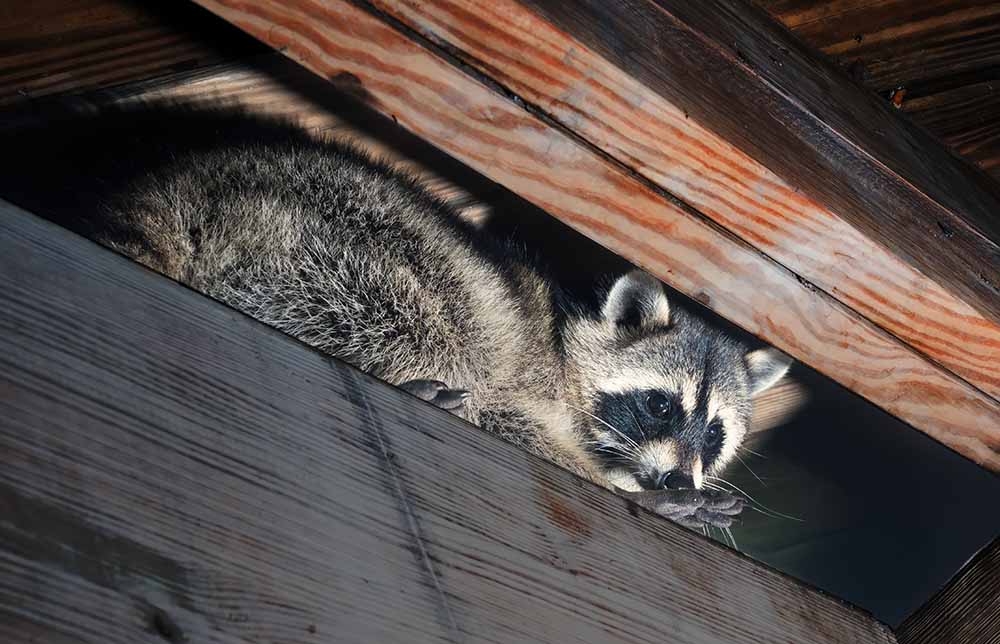
Among the sounds every homeowner dreads is the pitter-patter of tiny feet overhead. Unfortunately, an attic or crawlspace makes an attractive home to all sorts of critters including mice, squirrels, bats, and raccoons, and the scurrying and squeaking you may hear is hardly the worst of it. An animal nesting in your attic can cause all sorts of problems, from spreading disease through their droppings to chewing electrical wires. To keep these unwanted tenants from getting too comfortable - and to prevent further damage to your home - it’s important to take action as soon as possible. Here’s what you need to know about nesting animals, and how to safely deal with them.
Who’s there? How do they get in? How to get them out The DIY approach Best practices Preventative measures
Who’s there?
In Canada, the main culprits for nesting in homes include squirrels, rats, mice, raccoons, bats, and pigeons. It’s sometimes possible to tell what kind of critter has established residence by the types of sounds it makes and the hours during which it’s most active. Mice and rats, for instance, can often be heard scurrying and chewing across your ceiling and inside your walls. Other creatures, like bats and raccoons, will be quiet during the day and active from dusk until dawn. If an animal has built a home in your attic during nesting season, you may also hear the high-pitched squeaks of babies.
How do they get in?
Animals – particularly urbanized ones – are adept at making their homes in a wide range of spaces, both natural and human-made. Your attic, which is warm, sheltered, and safe from predators, makes a particularly attractive place, especially for mothers looking for a spot to build a nest. Holes and gaps in soffits, fascia, dormers, gable vents, and roof ridge vents are all common access points, but you may be surprised at the size of hole an animal can use to gain entry. While raccoons can create basketball-sized holes to get into your attic, bats and mice can make do with a hole as small as a dime.
How to get them out
The best and easiest way to get a nesting animal out of your attic is to call a professional. Not only do wildlife control professionals have the training and tools to remove a nesting animal, but they will also be aware of the regulations around what you can and can’t do. For example, bats are protected species in Canada and it is illegal to harm or kill one – even if it’s flying around your living room. It’s also illegal in many places to trap an animal and move it to a new area, not to mention potentially dangerous. Bats, raccoons, and squirrels can carry rabies, a virus that’s fatal to humans, so anyone who may come into contact with these animals should be vaccinated as a precaution.
The DIY approach
While it’s always advisable to call a professional, there are a few cases in which the DIY method could work. Snap traps, for example, are still considered one of the best ways to get rid of rats and mice – although you’ll need to be able to stomach dealing with the dead ones. If a family of squirrels has made a home in your attic, it’s not advisable to attempt to remove them or install a one-way door (which will trap the mother outside and the babies inside). If you make it less inviting by shining bright lights, playing talk radio, and hanging rags soaked in ammonia or vinegar in the attic or near their entrance, or simply wait for the end of nesting season, the squirrels may leave on their own.
Best practices
The worst thing you can do about a nesting animal in your attic is nothing. The longer animals are allowed to remain in residence, the more damage they can do to your home, including destroying insulation, leaving droppings, and creating holes in your roof. That’s why it’s important to consult a professional as soon as you become aware of the issue.
Preventative measures
The best way to protect your home against nesting animals is to take action before they move in. Trim trees away from the roofline to make it harder for squirrels and raccoons to gain access, and eliminate other nesting spaces in your yard like brush piles and rock piles. You should also regularly inspect your roofline for holes and gaps, and make repairs as needed.
Jeremy Freed is a freelance writer and editor based in Toronto. His writing about fashion, travel, food and design appears in Sharp, Harry and re:Porter magazines, among many others.